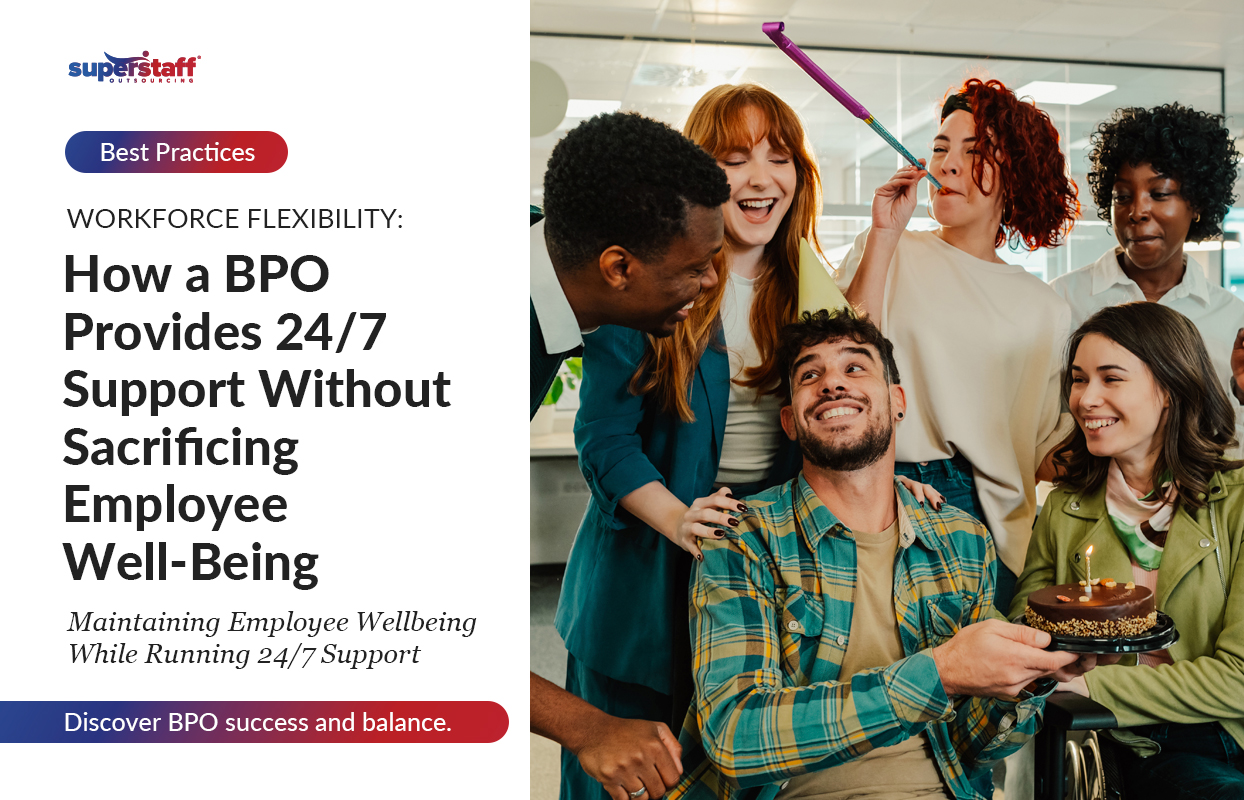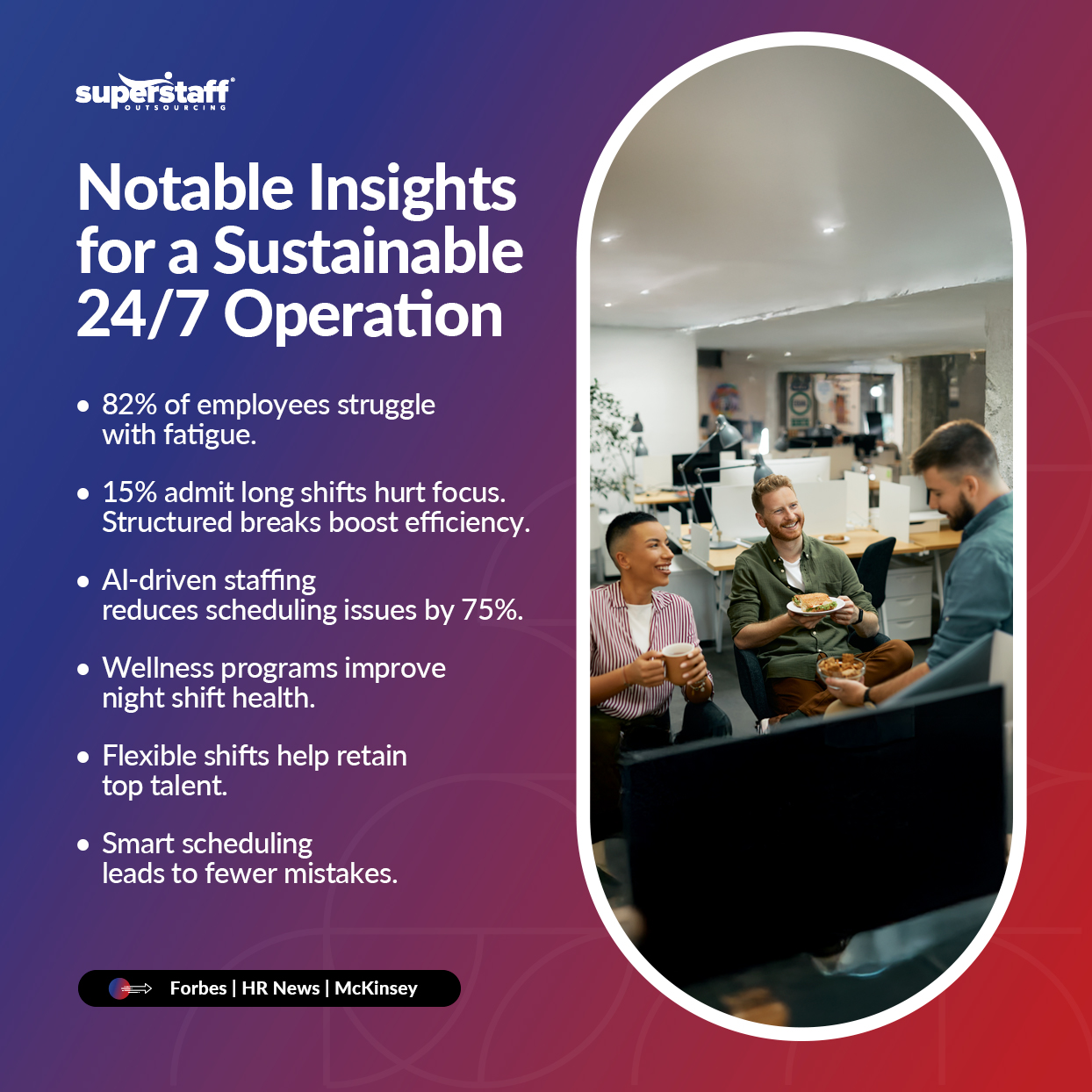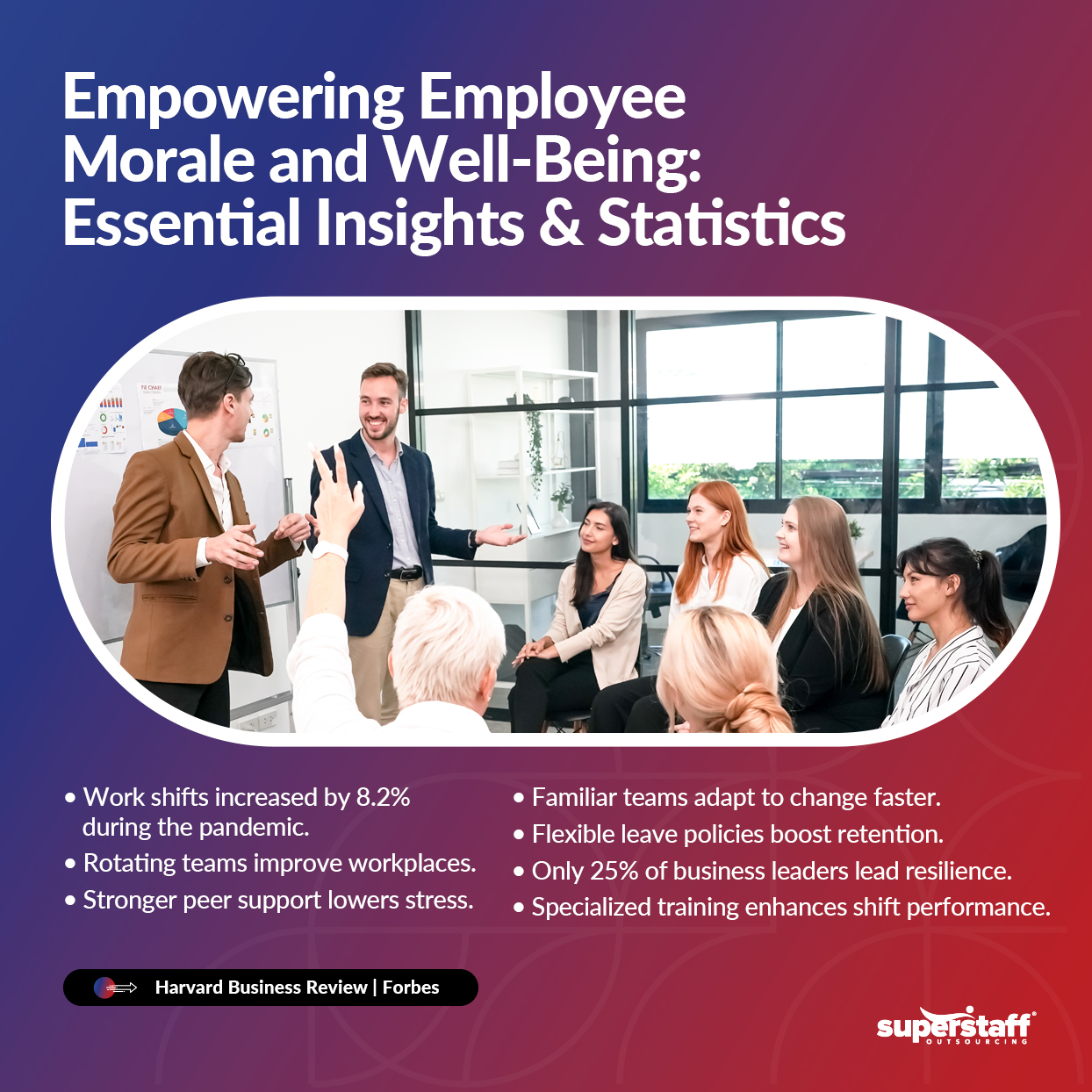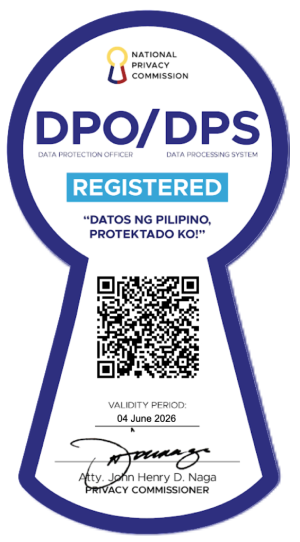
Providing 24/7 customer support has been proven to be a competitive advantage. Given this, it is also a robust business necessity.
However, keeping employees engaged and productive around the clock without pushing them to exhaustion is a challenge that must be continuously addressed. So, how do BPOs tackle this? This is where workforce flexibility comes in.
The best BPO providers use smart scheduling, AI-driven workload management, and employee-first policies to maintain high service levels while prioritizing well-being. When done right, a flexible workforce covers late-night shifts while ensuring consistent quality, reducing turnover, motivating employees, and lessening fatigue. We’re here to explore how BPO providers do it right.
In this article, we will explain how BPOs achieve a flexible work environment without sacrificing employee health. If your business relies on continuous support, these strategies will show you how outsourcing can provide operational excellence and a healthier, happier team. We will also explore the benefits of a flexible workforce.

Maximizing Productivity with Energy-Based Shift Cycles
Running a 24/7 operation without overburdening employees requires more than filling time slots. Leading BPOs recognize that your employees’ rest and mental state directly impact their performance just as much as how they work. By aligning shifts with employees’ natural productivity peaks, companies can maintain high-quality service while reducing burnout and turnover.
Why Timing Matters in Workforce Flexibility
Not all hours in a workday are created equal. Some employees are naturally more productive in the morning, while others perform at their best in the evening or late at night. When timing isn’t set to cater to employee’s needs, morning persons or night owls may struggle to keep up with demands. To add to this, according to Forbes, 82% of employees are at risk of being burnt out. A one-size-fits-all scheduling model forces employees to operate outside their optimal performance windows, leading to:
- Decreased focus and accuracy – Employees working against their natural rhythms are more prone to errors and slower response times.
- Higher burnout rates – Forcing early risers or night owls into morning shifts creates unnecessary stress and fatigue.
- Lower engagement and job satisfaction – Employees who feel drained at work are likelier to disengage and seek opportunities elsewhere.
How BPOs Optimize Scheduling for Peak Performance
Instead of assigning shifts based solely on operational needs, forward-thinking BPOs use a data-driven approach that factors in:
- Employee preference surveys – Identifying whether an agent thrives in early, mid, or late shifts.
- Performance analytics – Evaluating past work performance at different times of the day to determine when employees are most productive.
- AI-powered workforce management – Using machine learning to track energy levels and optimize schedules accordingly.
By leveraging these insights, BPOs can match employees with shifts that align with their natural rhythms, leading to:
- Higher productivity and efficiency – Employees perform at their best during peak energy hours.
- Reduced error rates and improved accuracy – Alert employees handle customer interactions with greater precision.
- Lower absenteeism and turnover – Employees who work during their most effective hours experience less stress and higher job satisfaction.
Smart scheduling isn’t just about covering shifts. It’s about creating a flexible workforce that performs at its best without burning out. Next, let’s discuss how strategic micro-breaks help sustain that energy throughout the shift.
Boosting Focus Through Micro-Breaks for a Flexible Workforce
Keeping employees engaged and performing at their best during long shifts requires more than scheduling the proper hours. It also involves managing their energy throughout those hours. Strategic micro-breaks are the most effective way to maintain focus and productivity in a 24/7 support environment.
Why Micro-Breaks Matter in a High-Performance Workplace
BPO employees handle a fast-paced, high-volume workload that requires sustained concentration. Maintaining focus for long hours can have unhealthy and adverse effects on an employee’s well-being and productivity. Studies have shown that 15% of employees admit to being distracted during their work shifts. Given this data, we can relate to taking breaks amidst intense or busy shifts to maintain focus and rest.
How Leading BPOs Implement Micro-Break Strategies
High-performing BPOs don’t leave productivity to chance. They integrate structured micro-breaks into shifts using data-driven scheduling models that balance employee well-being with operational efficiency. Here’s how:
- Pre-Scheduled Short Breaks – Employees take quick breaks at set intervals, such as every 60 to 90 minutes, to prevent burnout.
- Wellness-Oriented Breaks – Employees are encouraged to stretch, hydrate, or do quick mindfulness exercises to recharge effectively instead of passive downtime.
Smart BPOs understand that workforce flexibility isn’t just about scheduling—it’s about sustaining peak performance throughout every shift. Next, we’ll look at another key strategy: how wellness incentives tailored to different shifts help employees stay healthy, engaged, and ready to perform.
Tailoring Wellness Incentives to Shift Needs
Running a 24/7 operation is about sustaining an engaged, alert, and healthy workforce across different shifts. Employees working unconventional hours face unique challenges, from disrupted sleep cycles to increased stress and long-term health risks. Forward-thinking BPOs recognize this and design wellness programs that align with the demands of night and rotating shifts rather than applying a one-size-fits-all approach.
Extended exposure to irregular schedules affects more than just productivity. Studies by Forbes revealed that longer work hours can be associated with long-term brain impairment. To add to that study, without targeted wellness initiatives, these challenges can lead to:
- Declining performance and focus – Employees struggle to maintain cognitive sharpness, leading to slower response times and more service errors.
- Increased absenteeism – Poor health and exhaustion result in frequent callouts, impacting operational stability.
- Higher turnover rates – Long-term strain pushes employees to seek roles with more predictable hours.
How BPOs Create Effective, Shift-Specific Wellness Initiatives
Leading providers embed employee well-being into their operational model. The most effective strategies focus on sustainability, accessibility, and tangible impact.
- Nutritional Support Tailored to Work Hours – Employees working overnight require different fuel than those on day shifts. Some BPOs offer light but energy-sustaining meal options to prevent sluggishness and optimize focus without disrupting sleep later.
- Workplace Recovery Spaces – Instead of standard breakrooms, some firms provide quiet zones for decompression, enabling employees to recharge mentally during off-peak hours.
- On-Site Fitness & Movement Programs – Light movement between calls or structured activity options can counteract the sedentary nature of support roles, reducing the risk of repetitive strain injuries and improving overall well-being.
- Guided Stress Reduction & Sleep Optimization – These initiatives help employees adjust to non-traditional hours without long-term health consequences, from relaxation exercises to sleep hygiene coaching.
For decision-makers like you considering outsourcing, a provider’s approach to employee well-being reflects its ability to sustain long-term, high-quality service delivery. The next step in optimizing workforce performance is leveraging AI-driven workload balancing to ensure employees operate efficiently without unnecessary strain.
Optimizing Workflows with AI-Driven Workload Balancing
The BPO industry is a high-demand, always-on environment. Efficiency in this industry revolves around ensuring the right employees are working at the correct times. Traditional scheduling methods often fall short, either stretching teams too thin during peak hours or leaving them underutilized during slower periods. The result? Employee fatigue, unnecessary labor costs, and inconsistent service levels.
This is where AI-driven workload balancing transforms operations. By leveraging real-time data, BPOs can dynamically adjust staffing levels to match customer demand, ensuring resources are allocated with precision.
More Imaginative Staffing Through Predictive Intelligence
Instead of relying on static schedules, BPOs integrate AI-powered systems that continuously analyze patterns in customer interactions, call volumes, and agent performance. This allows for:
- Demand-based staffing – AI forecasts peak and off-peak hours, ensuring coverage matches actual service needs.
- Real-time workload distribution – Incoming tasks are intelligently routed based on agent availability, expertise, and performance history.
- Proactive resource allocation – Workflows adjust dynamically, preventing bottlenecks while avoiding unnecessary idle time.
Eliminating manual guesswork as an approach keeps teams engaged without overloading them, allowing employees to work at a sustainable pace while maintaining high-quality customer interactions. Data by McKinsey back this up, showing that smart scheduling has reduced work disruptions by 75%; they also add 67% of lessened job delays.
A key differentiator when outsourcing customer support is the ability to scale dynamically without disrupting employee well-being. The next step is strengthening workplace morale through team-based rotations that foster collaboration and engagement, especially in round-the-clock operations.
Building Team Morale with Group Rotations

Sustaining a high-performing workforce in a 24/7 environment requires more than just smart scheduling and workload balancing. Team morale is critical in employee retention, engagement, and overall service quality. One of the most effective strategies BPOs use to foster a supportive work environment is group-based shift rotations.
Instead of assigning employees to shifts individually, forward-thinking BPOs schedule entire teams to rotate. This approach minimizes the emotional and psychological strain of working unconventional hours while strengthening collaboration, trust, and team accountability.
Employees working night or rotating shifts often face social disconnection, higher stress levels, and difficulty adjusting to changing schedules. When individuals are constantly shuffled between different teams, they lack the stability and peer relationships needed for long-term engagement. Those working from home at night may also experience these symptoms. According to Harvard Business Review, work schedules among approximately 3.1 million people had an 8.2% increase during the pandemic.
Team-based rotations counter these challenges by:
- Creating a sense of familiarity – Employees consistently work with the same colleagues, fostering stronger relationships and a sense of belonging.
- Providing built-in peer support – Working alongside trusted teammates allows for shared problem-solving, reducing the emotional toll of demanding shifts.
- Enhancing knowledge-sharing – Experienced team members mentor newer employees, leading to faster skill development and higher overall efficiency.
Leading outsourcing providers carefully design rotation systems that balance operational efficiency with team cohesion. Some key considerations include:
- Rotating teams rather than individuals – Ensuring relationship continuity improves engagement and reduces isolation.
- Aligning rotations with business demand – Strategic shifts ensure experienced teams cover peak hours while maintaining consistency.
- Integrating leadership into rotations – Assigning team leads to guide and motivate employees through shift transitions.
This approach benefits employees and drives business performance. Teams that stay together adapt faster to workflow changes, experience fewer disruptions, and deliver more consistent customer experiences.
When evaluating outsourcing partners, workforce cohesion is just as important as technical capability. A well-structured, team-oriented shift rotation model ensures employees remain motivated and customers receive consistent, high-quality service, regardless of hours.
What’s the next key factor in workforce well-being? Flexible paid time off (PTO) ensures employees maintain work-life balance without disrupting service levels.
Flexible PTO: A Smarter Approach to Workforce Flexibility in a 24/7 Operation
In an industry where continuous availability is essential, flexible paid time off (PTO) is a strategic investment in workforce stability. Unlike rigid leave policies that can disrupt service levels or force employees to choose between personal obligations and job responsibilities, a well-structured PTO system ensures that business continuity and employee well-being remain priorities.
BPOs that offer customizable time-off options empower employees to manage their schedules around key life events without professional disruption. This flexibility is especially critical for night shift and rotating employees, who may have different personal needs than those working traditional hours. Whether attending a family commitment, managing health needs, or simply taking time to reset, employees perform better when they know they have control over their time.
Beyond improving job satisfaction, strategic PTO policies reduce burnout, increase engagement, and lower turnover. Forbes data revealed that 83% of employees emphasize the importance of flexible shifts. Employees who can recharge without guilt return more focused, directly impacting service quality and productivity. Leading BPOs integrate PTO planning into their workforce management systems, ensuring that staffing levels remain optimized while allowing employees to take necessary time off.
Businesses outsourcing their customer support should have a flexible time-off structure, reflecting the provider’s commitment to long-term employee retention and performance. A workforce that feels valued and well-supported is more likely to deliver consistent, high-quality service, no matter the shift.
The final puzzle piece is preparing employees for shift work with resilience training, equipping them with the tools to thrive in a demanding but rewarding environment.
Building Resilience with Shift-Specific Training
Resilience training equips employees with strategies to maintain wellness and adapt to various shift patterns. BPOs provide training on stress management, nutrition, and sleep tailored to shift work, helping employees stay resilient. Improved stress management and shift-tailored wellness practices increase employee retention and satisfaction.
With the fast-paced 24/7 support environment, technical skills alone aren’t enough. Employees need the mental and physical resilience to manage demanding shift schedules without compromising their well-being or performance. Forbes revealed in their data that, unfortunately, only a tiny 25% of global leaders lead resilient workforces. Knowing this, BPOs recognize it and integrate shift-specific resilience training into their workforce development strategies.
Unlike generic employee wellness programs, resilience training is tailored to the realities of nontraditional work hours. It equips employees with practical strategies for managing stress, optimizing sleep cycles, and maintaining overall health—factors directly impacting job effectiveness and long-term career sustainability. Employees learn how to adjust their routines to prevent burnout, sustain energy levels, and improve focus, ensuring they remain productive and engaged throughout their shifts.
Key training areas include stress management techniques that help employees maintain composure during high-pressure interactions, nutrition education designed to support sustained energy and mental clarity, and sleep optimization strategies that enable shift workers to improve rest quality despite unconventional hours. These programs enhance individual performance and create a more stable workforce by reducing absenteeism, boosting morale, and increasing employee retention.
For businesses outsourcing their customer support, a BPO’s resilience training approach directly indicates its ability to maintain a high-performing, engaged team. By proactively equipping employees with the tools to succeed in nontraditional work environments, BPOs ensure consistent service delivery, more substantial workforce longevity, and a healthier, more committed team.
When workforce flexibility is done right, businesses don’t have to choose between 24/7 availability and employee well-being; they can have both.
Experience Workforce Flexibility with SuperStaff
Providing round-the-clock service should not compromise employee well-being. The best BPOs create a flexible, supportive environment in which teams stay engaged, productive, and motivated regardless of shift or location.
SuperStaff helps businesses achieve this balance with smart scheduling, AI-driven workload management, and employee-first policies. Our tailored solutions ensure seamless 24/7 support while keeping teams energized and committed. Let’s build a strategy that works for your business and your people. Contact SuperStaff today to learn how we can help you scale customer support without compromise!






